Coach Ramirez once spotted a quiet shift in a star player’s step during a pregame warm-up. The change was subtle, but paired with continuous data it became a clear sign to pause and assess.
The right system turns raw readings into timely insights. Teams can spot fatigue, tune training, and shorten downtime by acting early.
![]()
Modern solutions combine an AI injury tracker, IoT health monitoring, and a wearable recovery app so coaches and clinicians see the same numbers. This unified way avoids data silos and speeds decisions.
Expect devices that capture heart rate, movement patterns, and load metrics, then feed cloud platforms for simple dashboards. Choosing the right partner, like Iottive, ensures BLE device integration, secure data flows, and faster time-to-value.
Key Takeaways
- Unified systems turn data into actionable insights for safety and performance.
- Continuous monitoring helps detect risks earlier and guide recovery plans.
- Look for validated devices, comfort, and reliable battery life.
- Platform integration avoids silos and aligns medical and coaching teams.
- Expert partners speed deployment and tailor solutions to your team.
Why Smart Sports IoT Now: The Future of Injury Prevention and Athlete Care
Continuous sensing and smart analytics let staff spot subtle trends long before symptoms show.
From reactive treatment to proactive, real-time prevention
Teams are moving from periodic checks to nonstop data collection that enables timely intervention. Continuous streams of data create context around load, sleep, and activity so clinicians and coaches make aligned choices fast.
Future outlook: edge artificial intelligence, better sensors, and continuous monitoring
Advances in sensor fidelity and battery life mean devices will be more accurate and comfortable. Edge machine learning will analyze signals near the athlete to lower latency and protect privacy.
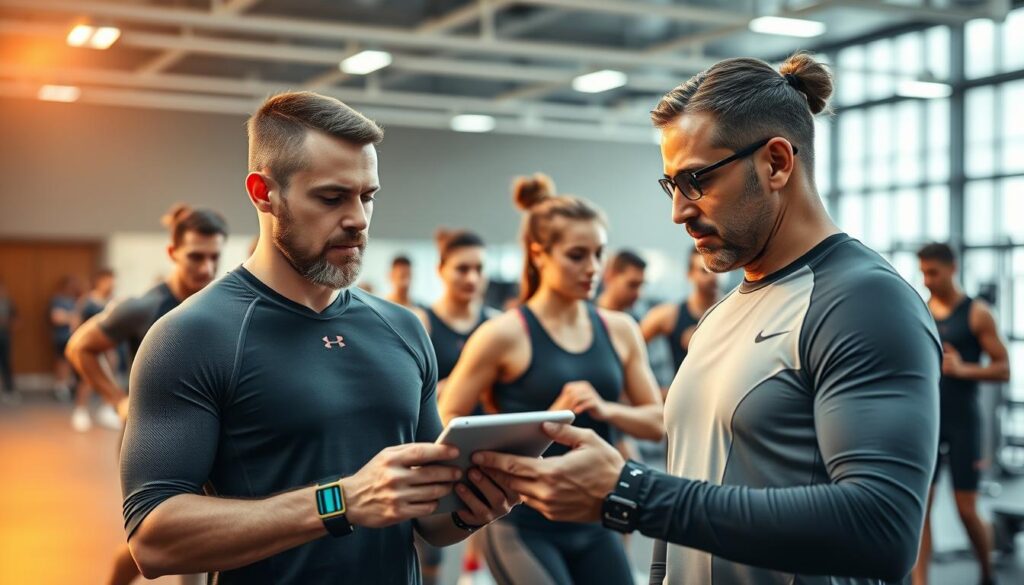
“Proactive care depends on clean data and clear workflows so insights become consistent action across teams.”
- Practical impact: wearables and devices can reveal fatigue and biomechanical shifts before they worsen.
- Platform role: cloud dashboards aggregate multi-athlete trends for benchmarking and season planning.
- Partner value: Iottive’s end-to-end IoT/AIoT and BLE expertise helps deploy sensor-to-dashboard solutions that support proactive care models.
AI injury tracker, IoT health monitoring, wearable recovery app
A modern sports stack links sensor-rich devices with cloud analysis to turn signals into clear action.
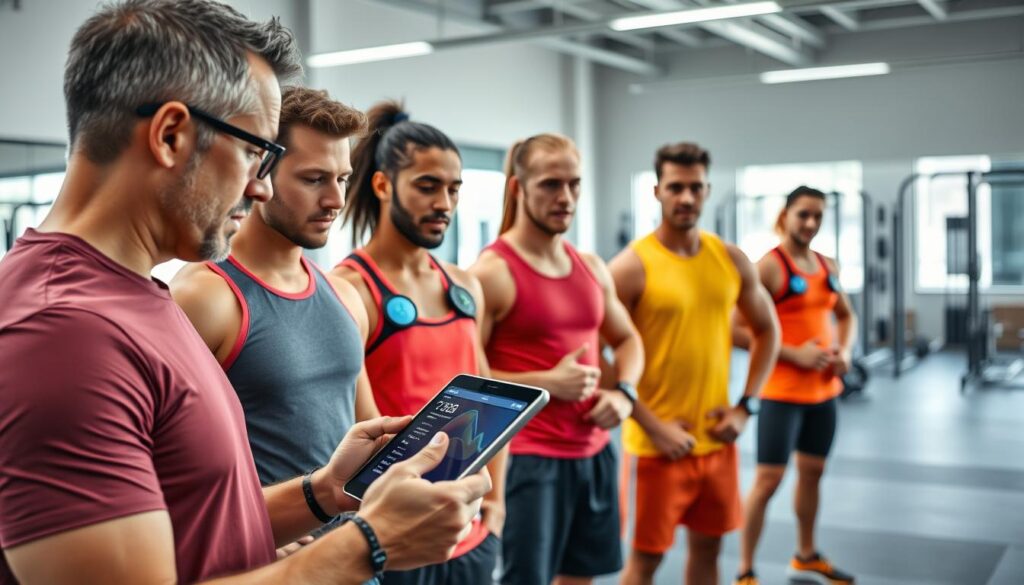
Core definitions and how they work together
- AI injury tracker: software and models that turn sensor readings into early warnings, risk scores, and actionable recommendations across an athlete’s lifecycle.
- IoT health monitoring: the end-to-end pipeline—devices, gateways, mobile apps, and cloud services—that delivers continuous visibility into key metrics.
- Wearable recovery app: the user layer that converts analysis into daily plans, checklists, and feedback to support adherence.
Where each fits in a modern sports medicine workflow
Sensors and wearables capture heart rate, respiration, temperature, SpO2, activity, and sleep plus sport-specific biomechanics.
Mobile software manages BLE syncing and short-term storage. Cloud services handle long-term storage, analysis, alerts, and dashboards.
Professionals—from athletic trainers to team physicians—use the same insights to inform prevention, return-to-play timelines, and day-to-day rehab decisions.
Example: combine fitness trackers for wellness baselines with EMG or impact sensors for biomechanics. That mix gives a fuller view of load and movement quality.
Key metrics—HRV, load, asymmetry, sleep quality, and impact events—roll up into dashboards and alerts aligned to training phases and medical checkpoints.
The Data That Matters: Heart rate, HRV, sleep, activity, and impact insights
Clear, consistent signals from sensors let teams spot meaningful shifts before they affect performance.
Physiological metrics
Core signals include heart rate, respiration, temperature, and SpO2. Consistent baselines make deviations easier to interpret as actionable signs.
Movement and biomechanics
Gait patterns, joint load, asymmetry, and impact forces reveal form breakdowns early. Sports-grade wearables and helmet systems record head impacts and mechanical stress.
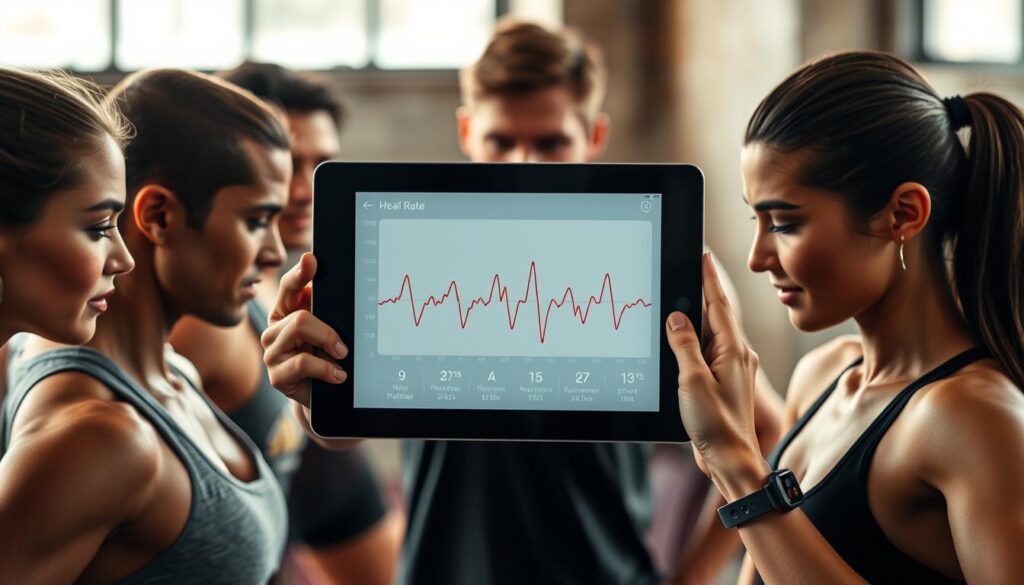
Recovery signals
Sleep stages and sleep efficiency map to restoration needs. Heart rate variability adds context for fatigue and guides training intensity against subjective readiness.
- Device features: multi-sensor fusion, onboard analysis, and ECG or PPG improve heart insights and reduce false alarms.
- Data normalization: platforms like Iottive aggregate data across sensors to create unified dashboards for coaches and clinicians.
- Performance indicators: strain, readiness, and load metrics link daily activity levels to longer-term risk and season planning.
From Sensors to Decisions: How AI and machine learning turn real-time data into action
Sensor streams become decisions when models turn noisy signals into clear guidance for staff and athletes.
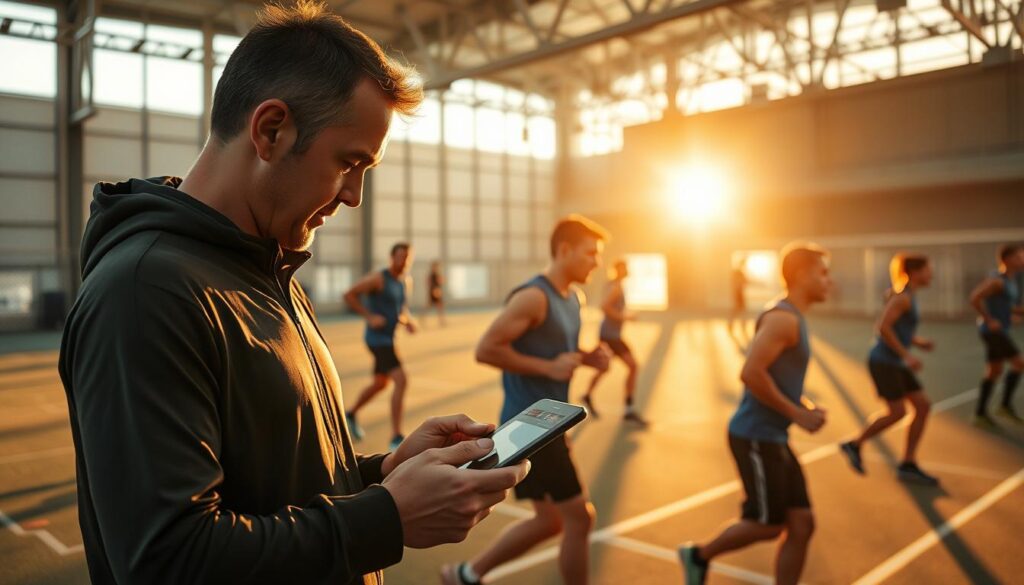
Raw accelerometer, PPG, and ECG feeds pass through pipelines that remove noise and extract features. Feature extraction and analysis power anomaly detection and practical insights for teams.
Anomaly detection and early warning signs to prevent injuries
Models flag abrupt drops in HRV, sudden sleep disturbances, and high-impact events as early warning signs. Those alerts prompt clinician review and targeted investigation.
Personalized plans: adaptive training and recovery recommendations
Personalized plans adapt daily based on incoming data. Heart rate and movement features combine to estimate exertion and set performance targets that respect cumulative stress.
- Real-time nudges: in-session feedback helps adjust load on the spot.
- Longitudinal analysis: cloud aggregation reveals trends for season planning.
- Validation and trust: model validation, clinician sign-off, and auditable, evidence-based data keep recommendations credible.
“On-device models cut latency; cloud models learn from cohorts. The right balance keeps responses fast while improving accuracy over time.”
Iottive builds machine learning pipelines, BLE integrations, and cloud bridges that turn sensor feeds into clinician-ready recommendations and clear athlete feedback. This pipeline helps teams act fast to prevent injuries and protect long-term performance.
Key Use Cases Across Sports: Prevention, detection, recovery, and performance
Teams use targeted data streams to catch fatigue early, fix technique, and speed safe returns to play. Practical use cases show how signals become action across practice, competition, and rehab.
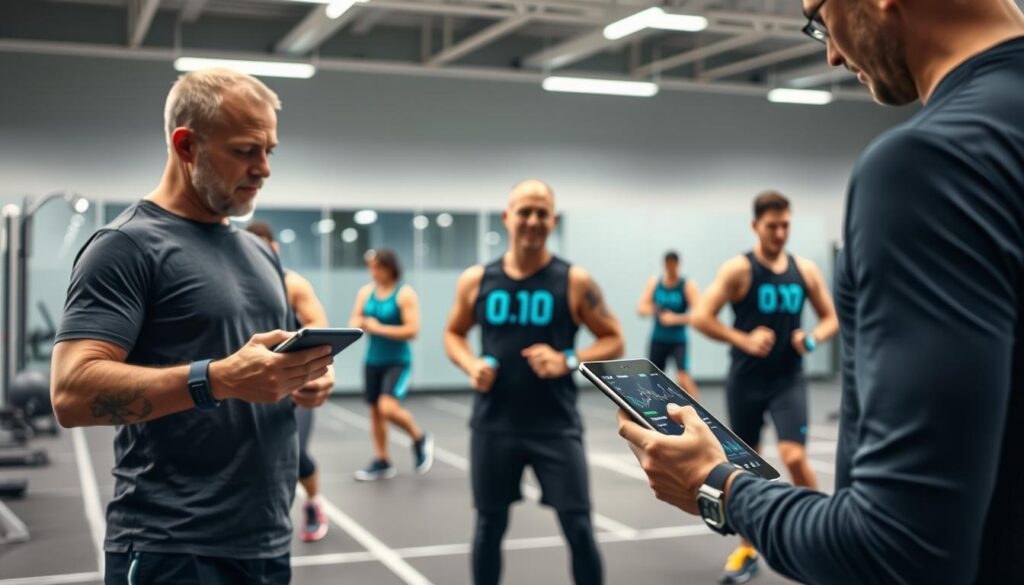
Monitoring fatigue to prevent overuse injuries
Fatigue monitoring combines heart rate variability, heart rate, sleep, and strain to flag rising load. Timely alerts let coaches scale sessions and prevent injuries before symptoms appear.
Biomechanics correction to reduce strain and improper technique
Motion trackers capture stride, asymmetry, and load to reveal technique breakdowns. Coaches use that data to prescribe drills that correct form and lower long-term strain.
Head impact detection and rapid concussion response
Helmet or mouthguard sensors quantify impact magnitude and direction. Immediate sideline alerts start established concussion protocols and protect athletes at the moment of contact.
Post-injury rehab tracking and return-to-play confidence
Recovery tracking logs adherence to exercises, range of motion, and day-over-day readiness. Combined with team dashboards, this data coordinates therapists, athletic trainers, and physicians.
“Clear roles and escalation pathways turn detection events into fast, consistent decisions that protect athletes while sustaining performance.”
- Example: combine trackers and a team dashboard so rehab tasks, progress, and clearance notes flow between staff.
- Devices must balance comfort and accuracy to capture valid data across travel, practice, and competition.
- Connecting these data streams focuses on the clinical signs staff value, so alerts become action—not noise.
Choosing Components: Wearables, smart garments, footwear sensors, and BLE connectivity
Match each device to a clear objective: load, muscle effort, stride, or daily readiness. Picking components this way keeps data actionable and reduces athlete burden.
Smartwatches and fitness trackers capture heart rate, activity, and sleep. They give broad daily context and are easy to deploy across a roster.
Smart clothing and EMG wearables
EMG garments measure muscle activation and effort. They guide load distribution and help design targeted recovery plans during rehab blocks.
Footwear and motion sensors
Foot sensors log impact and pressure distribution. Use them to find asymmetries, refine stride, and reduce mechanical stress in training.
BLE app development
Reliable BLE flows enable low-power syncing, background reconnection, and timely alerts without draining batteries. Think pairing UX, power management, and secure local storage.
- Device features that matter: sensor fidelity, battery life, comfort, and BLE reliability for continuous data flow.
- Combine general-purpose fitness trackers with sport-specific sensors for a fuller picture of daily readiness and performance.
- Integration patterns: SDKs, firmware updates, and encrypted mobile storage to keep data safe and apps responsive.
| Component | Primary Signals | Key Benefit | When to Use |
|---|---|---|---|
| Smartwatches / Fitness trackers | Heart rate, activity, sleep | Roster-level baseline and daily readiness | Daily wellness and session planning |
| EMG smart garments | Muscle activation, effort | Targeted muscle load and rehab guidance | Rehab blocks and technique tuning |
| Footwear & motion sensors | Impact, pressure, stride metrics | Gait analysis and asymmetry detection | Running loads and biomechanical review |
| BLE & Edge gateways | Device sync, local preprocessing | Low-latency sync and power savings | Continuous collection with minimal friction |
Iottive specializes in BLE development, cloud and mobile integration, and custom products that combine smartwatches, EMG garments, footwear sensors, and gateways into scalable solutions.
Solution Architecture: Cloud and mobile integration for coaches, clinicians, and athletes
A layered platform connects devices, mobile clients, and cloud services so staff see one consistent view.
Blueprint: sensors stream to BLE gateways and mobile clients, which push secure payloads to cloud ingestion services. That flow preserves context and delivers reliable real-time data to dashboards and role-based mobile screens.
Edge vs. cloud trade-offs
On-device machine learning filters noise and classifies activity for fast alerts and better privacy. Cloud models aggregate multi-user datasets to improve models and produce cohort-level insights.
Dashboards, alerts, and feedback loops
Dashboards prioritize signals, readiness scores, and progress against recovery goals. Alerts use thresholds, cooldowns, and escalation paths to cut false positives and drive meaningful action.
Development must cover cross-platform mobile work, BLE performance, offline sync, and secure ingestion so clinicians can trust the data history during clearance decisions.
| Layer | Role | Key Benefit |
|---|---|---|
| Sensors & devices | Capture signals at source | High-fidelity inputs for analysis |
| Edge / Mobile | Local filtering & alerts | Low-latency feedback and privacy |
| Cloud & Analytics | Aggregation & machine learning | Cohort insights and model updates |
| Apps & Dashboards | Role-based views | Actionable insights and feedback |
“Design choices should make it simple to add new sensors and scale models across teams.”
Governance: access controls, audit logs, and encrypted storage protect health data while enabling clinician review. A modular solutions stack lets teams roll out components without rebuilding core integrations.
Selection Criteria: How to evaluate a smart sports IoT system for your needs
A practical shortlist focuses on accuracy, integration, usability, and compliance from day one.
Accuracy, reliability, and validation of metrics
Assess how sensors perform under sport conditions. Check repeatability, tolerance to motion, and sweat effects.
Validate metrics like heart rate, activity levels, and sleep against lab references and field tests. Plan trials across training drills and competition to confirm real-world fidelity.
Interoperability: APIs, EHR compatibility, and data standards
Prefer API-first vendors with secure webhooks and support for common healthcare formats. EHR integration reduces silos and speeds clinician workflows.
Look for open interfaces that let IT map feeds into existing clinical systems without heavy rework.
User experience: comfort, battery life, and adherence
Comfort and intuitive mobile flows drive long-term use. Test battery life across multi-day travel and peak activity levels.
UX research and clinician feedback improve adherence and trust in daily plans and alerts.
Security, privacy, and compliance considerations (HIPAA)
Require encryption at rest and in transit, role-based access, and full audit trails. These controls protect patient privacy and meet regulatory needs.
Vendor roadmaps and development support matter. Iottive helps with validation planning, API-first integration, and HIPAA-aligned architectures to match your long-term plans.
“Choose solutions that meet performance targets while protecting data and organizational risk profiles.”
Real-World Inspirations: What elite sports and health leaders are using
Elite teams pair league-proven devices with club systems to turn season-long signals into clear coaching steps.
Examples across leagues
Load, GPS, and impact sensing in action
NFL clubs deploy Riddell’s InSite helmet for impact detection and fast sideline checks. The NBA uses Catapult sensors to manage load and reduce fatigue across dense schedules.
European football relies on GPS wearables to track distance, speed, and acceleration. Those feeds map to load thresholds tied to lower injuries and smarter session planning.
Consumer-to-pro bridge
Apple Watch, WHOOP, and Oura supply heart rate, heart rate variability, and sleep metrics that slot into team dashboards. Combining team-grade devices with consumer wearable devices widens coverage without losing fidelity.
| League | Device Type | Primary Use |
|---|---|---|
| NFL | Helmet sensors (Riddell InSite) | Impact detection and sideline workflow |
| NBA | Player GPS & IMU (Catapult) | Load tracking and fatigue management |
| European Football | GPS wearables | Distance, speed, acceleration thresholds |
“These inspirations show how data-led choices keep athletes safe and sustain performance across a season.”
Iottive integrates Catapult, GPS systems, Apple HealthKit, WHOOP, and Oura SDKs into unified analytics so coaches use consistent data for planning and AI-driven model updates.
Overcoming Challenges: Data quality, bias, equity, and clinician adoption
High-quality signals make the difference between a false alarm and an action coaches can trust. Focused work on sensor setup and signal processing improves the usefulness of every reading.
Improving signal quality and reducing false alarms
- Calibrate sensors and give clear placement guidance so devices collect consistent data.
- Use motion-artifact filters, adaptive thresholds, and contextual baselines to raise signal-to-noise over time.
- Iottive supports firmware and edge development that reduces this noise at the source.
Inclusive models and clinician adoption
Diverse training datasets and continuous bias audits help ensure models apply across age, gender, and ethnicity. Equity also means offering loaner programs and cost-sensitive bundles so more athletes access the same tools.
Privacy and security use encryption, access control, and audit logs to build trust among professionals and athletes. Integrations with EHRs and clinician-centric UX reduce clicks and highlight the most relevant signs, improving adoption.
“Clear signals, fair models, and usable workflows turn data into shared decisions that better prevent injuries.”
About Iottive: End-to-end IoT/AIoT development for smart sports solutions
Iottive delivers full-stack development from firmware through cloud so teams launch connected sports platforms faster.
Expertise in BLE app development, cloud & mobile integration, and custom IoT products
Development covers BLE firmware, mobile clients, secure ingestion, and analytics dashboards.
Our engineering blends embedded work with cloud pipelines so multi-sensor feeds become coach- and clinician-ready.
Industry experience across multiple sectors
We apply patterns proven in Healthcare, Automotive, Smart Home, Consumer Electronics, and Industrial IoT.
Cross-industry lessons speed delivery and lower risks for sports programs with specific operational needs.
Build your monitoring, wearable devices, or recovery-centric platform
- End-to-end development: firmware, BLE app development, cloud & mobile integration, and analytics.
- Device integration: unify diverse devices and wearable devices into cohesive solutions that reduce integration work.
- Tailored to needs: role-based features, secure access, and timely feedback for coaches, clinicians, and athletes.
- Design for adherence and comfort so wearables fit daily routines and season rhythms.
- We help you launch a recovery-focused platform that scales with your program.
Ready to align scope, timelines, and outcomes? Start a conversation at www.iottive.com or sales@iottive.com.
Conclusion
, A unified platform turns diverse signals into straightforward guidance staff can act on every day.
Recap: A well-chosen system unites data from wearables and devices into clear insights that improve health, performance, and season-long recovery outcomes.
The best path fits daily routines and uses monitoring and feedback to deliver just-in-time nudges without overload. Standardize around validated metrics—like heart rate, HRV, sleep, and load—so return-to-play and training calls stay consistent and defensible.
Bridge consumer and pro ecosystems to gather the right signal quality while keeping comfort and adherence high. Proactive prevention, focused rehab plans, and tight feedback loops reduce risk and boost availability when it matters most.
Iottive is ready to design end-to-end solutions—BLE apps, cloud analytics, and mobile experiences—to move you from strategy to execution. Contact www.iottive.com | sales@iottive.com.
FAQ
What should I consider when choosing a smart sports monitoring system?
Look for validated metrics, reliable sensors, comfortable hardware, strong battery life, and seamless connectivity. Prioritize systems with clear data standards, API support, and clinician- or coach-facing dashboards to turn measurements into actionable plans.
How do real-time systems shift care from reactive to proactive?
Continuous data capture and edge analytics enable early detection of abnormal patterns such as rising fatigue or altered gait. That allows coaches and clinicians to intervene sooner with load adjustments, technique changes, or rest prescriptions before problems escalate.
What roles do sensors, wearables, and software play together?
Sensors capture physiological and biomechanical signals; firmware and BLE handle transmission; mobile and cloud software aggregate, analyze, and visualize data. Machine learning models then convert raw inputs into readiness scores, trend alerts, and personalized recommendations.
Which physiological metrics are most useful for athlete care?
Heart rate, heart rate variability (HRV), respiration rate, SpO2, and skin temperature offer insight into stress, recovery, and illness. Combining these with sleep and subjective wellness data improves prediction of readiness and fatigue.
What movement measures help detect mechanical risk?
Gait symmetry, joint load estimates, stride length, impact force, and range-of-motion trends flag technique problems and overuse risk. EMG and inertial sensors add muscle activation and timing context to refine interventions.
How do systems identify early warning signs for problems?
Anomaly detection models monitor baselines and flag deviations in physiological or biomechanical signals. Multimodal patterns—like elevated resting heart rate plus poor sleep and reduced stride efficiency—trigger prioritized alerts for review.
Can these solutions create personalized training and recovery plans?
Yes. Adaptive algorithms use individual baselines, response history, and sport-specific thresholds to suggest load adjustments, recovery modalities, and progressions. Coaches can tailor plans while clinicians manage rehab milestones.
What use cases deliver the most value across sports?
Monitoring fatigue to prevent overuse, correcting biomechanics to lower strain, detecting head impacts for rapid concussion response, and tracking rehab progress for safe return-to-play are high-impact applications for teams and athletes.
Which device types are best for different monitoring needs?
Smartwatches and wrist trackers suit broad physiological monitoring. Smart garments and EMG wearables are ideal for muscle activation and movement patterns. Footwear sensors excel at stride and load analysis. Choose hardware based on the primary metrics you need.
How important is BLE and app design in device integration?
Very important. Low-energy Bluetooth ensures reliable data transfer with minimal battery drain. Well-designed mobile apps manage firmware updates, pairing, real-time sync, and user prompts that boost adherence and data quality.
Should processing happen at the edge or in the cloud?
Use edge processing for low-latency alerts and to protect privacy when raw signals are sensitive. Cloud analytics support heavy model training, long-term trend analysis, and cross-athlete benchmarking. A hybrid approach often works best.
What evaluation criteria should organizations use when selecting a solution?
Assess accuracy and validation, interoperability with EHRs or performance platforms, user comfort and adherence, battery life, and compliance with security and privacy standards such as HIPAA where applicable.
Which commercial products bridge consumer and pro workflows?
Devices like Apple Watch, WHOOP, and Oura provide high-quality physiological data that teams and clinicians often integrate into broader workflows using APIs and supplemental sensors for sport-specific insights.
How do teams reduce false alarms and improve data quality?
Improve sensor placement, use signal filtering, calibrate models to population subsets, and combine multiple data streams. Regular validation and clinician review of flagged events help tune thresholds and reduce alert fatigue.
How can developers ensure inclusive, unbiased models?
Train on diverse datasets that reflect different ages, sexes, skin tones, body types, and skill levels. Continuously audit model performance and provide transparent error rates so clinicians can interpret outputs responsibly.
What privacy and security measures are essential for athlete data?
Implement encryption in transit and at rest, enforce role-based access controls, maintain audit logs, and comply with regional regulations such as HIPAA when handling protected health information. Clear consent flows and data minimization help maintain trust.
What experience does a full-service IoT development partner bring?
A capable partner delivers BLE app development, firmware expertise, cloud and mobile integration, data pipelines, and domain experience across healthcare, consumer electronics, and sports. That speeds time-to-market and reduces integration risk.